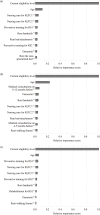Predicting demand for long-term care using Japanese healthcare insurance claims data
- PMID: 36310062
- PMCID: PMC9640742
- DOI: 10.1265/ehpm.22-00084
Predicting demand for long-term care using Japanese healthcare insurance claims data
Abstract
Background: Driven by the rapid aging of the population, Japan introduced public long-term care insurance to reinforce healthcare services for the elderly in 2000. Precisely predicting future demand for long-term care services helps authorities to plan and manage their healthcare resources and citizens to prevent their health status deterioration.
Methods: This paper presents our novel study for developing an effective model to predict individual-level future long-term care demand using previous healthcare insurance claims data. We designed two discriminative models and subsequently trained and validated the models using three learning algorithms with medical and long-term care insurance claims and enrollment records, which were provided by 170 regional public insurers in Gifu, Japan.
Results: The prediction model based on multiclass classification and gradient-boosting decision tree achieved practically high accuracy (weighted average of Precision, 0.872; Recall, 0.878; and F-measure, 0.873) for up to 12 months after the previous claims. The top important feature variables were indicators of current health status (e.g., current eligibility levels and age), risk factors to worsen future healthcare status (e.g., dementia), and preventive care services for improving future healthcare status (e.g., training and rehabilitation).
Conclusions: The intensive validation tests have indicated that the developed prediction method holds high robustness, even though it yields relatively lower accuracy for specific patient groups with health conditions that are hard to distinguish.
Keywords: Demand prediction; Healthcare insurance claims database; Long-term care service.
Conflict of interest statement
The authors declare that they have no competing interests.
Figures



Similar articles
-
Increased care-need in older long-term care insurance users after the 2018 Japan Floods: a retrospective cohort study based on the Japanese long-term care insurance claims.Environ Health Prev Med. 2023;28:31. doi: 10.1265/ehpm.22-00269. Environ Health Prev Med. 2023. PMID: 37197943 Free PMC article.
-
Rehabilitation services and related health databases, Japan.Bull World Health Organ. 2022 Nov 1;100(11):699-708. doi: 10.2471/BLT.22.288174. Epub 2022 Sep 20. Bull World Health Organ. 2022. PMID: 36324547 Free PMC article.
-
Effect of in-home and community-based services on the functional status of elderly in the long-term care insurance system in Japan.BMC Health Serv Res. 2012 Aug 4;12:239. doi: 10.1186/1472-6963-12-239. BMC Health Serv Res. 2012. PMID: 22863362 Free PMC article.
-
The use of Japanese long-term care insurance claims in health services research: current status and perspectives.Glob Health Med. 2021 Jun 30;3(3):142-148. doi: 10.35772/ghm.2021.01000. Glob Health Med. 2021. PMID: 34250289 Free PMC article. Review.
-
Considering long-term care insurance for middle-income countries: comparing South Korea with Japan and Germany.Health Policy. 2015 Oct;119(10):1319-29. doi: 10.1016/j.healthpol.2015.06.001. Epub 2015 Jun 11. Health Policy. 2015. PMID: 26117093 Review.
Cited by
-
Predicting Long-Term Care Service Demands for Cancer Patients: A Machine Learning Approach.Cancers (Basel). 2023 Sep 16;15(18):4598. doi: 10.3390/cancers15184598. Cancers (Basel). 2023. PMID: 37760567 Free PMC article.
-
Effects of self-monitoring using an accelerometer on physical activity of older people with long-term care insurance in Japan: a randomized controlled trial.Eur Geriatr Med. 2024 Apr;15(2):371-380. doi: 10.1007/s41999-024-00935-w. Epub 2024 Feb 14. Eur Geriatr Med. 2024. PMID: 38353911 Clinical Trial.
-
The financing sustainability of long-term care insurance: an example from Nanning, China.Front Public Health. 2025 Apr 22;13:1454037. doi: 10.3389/fpubh.2025.1454037. eCollection 2025. Front Public Health. 2025. PMID: 40331119 Free PMC article.
-
Association between bed-rest time, food intake, and constipation in older nursing home residents.Geriatr Gerontol Int. 2025 Apr;25(4):583-587. doi: 10.1111/ggi.70025. Epub 2025 Feb 28. Geriatr Gerontol Int. 2025. PMID: 40019003 Free PMC article.
References
-
- Dall TM, Gallo PD, Chakrabarti R, West T, Semilla AP, Storm MV. An aging population and growing disease burden will require a large and specialized health care workforce by 2025. Health Aff (Millwood). 2013;32(11):2013–20. - PubMed

